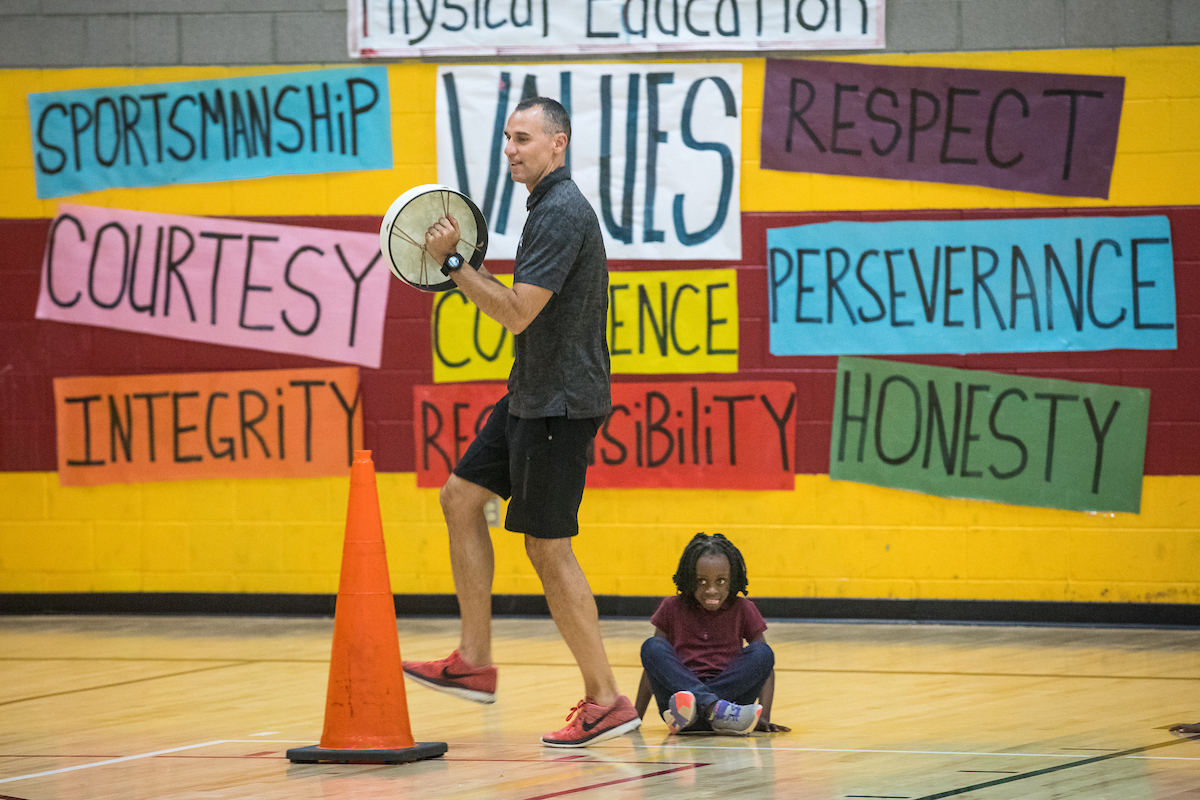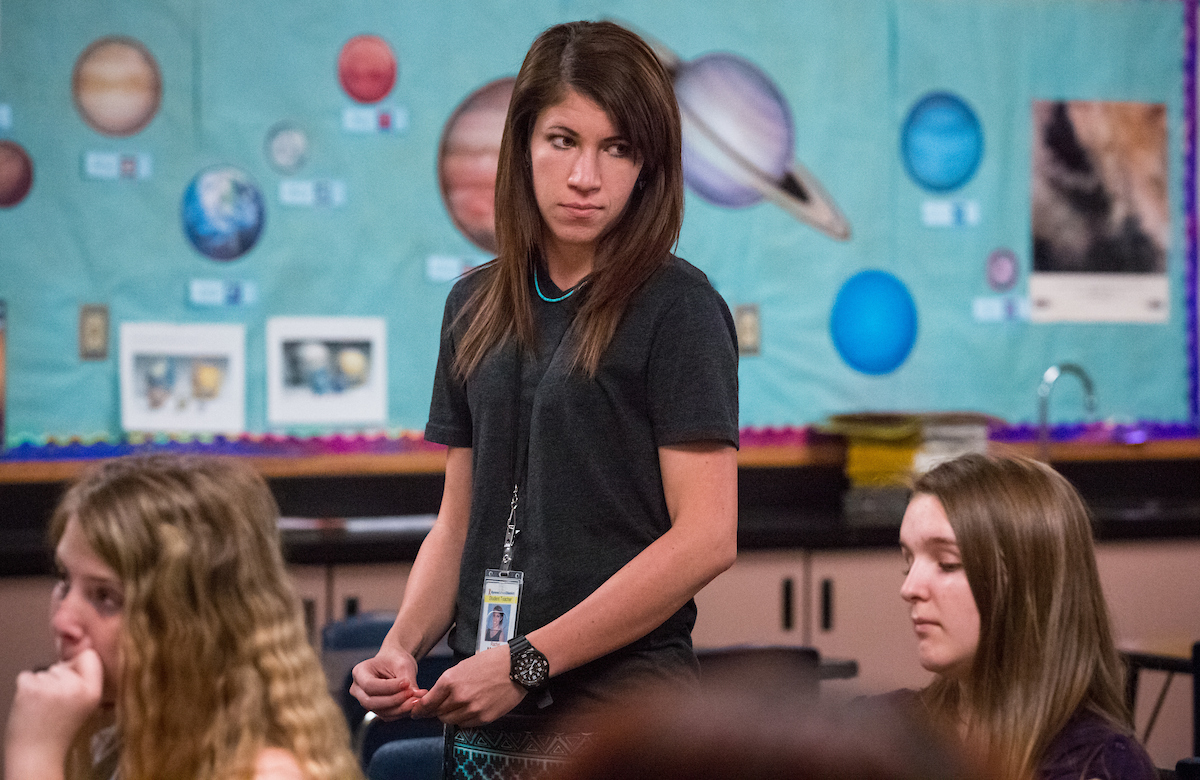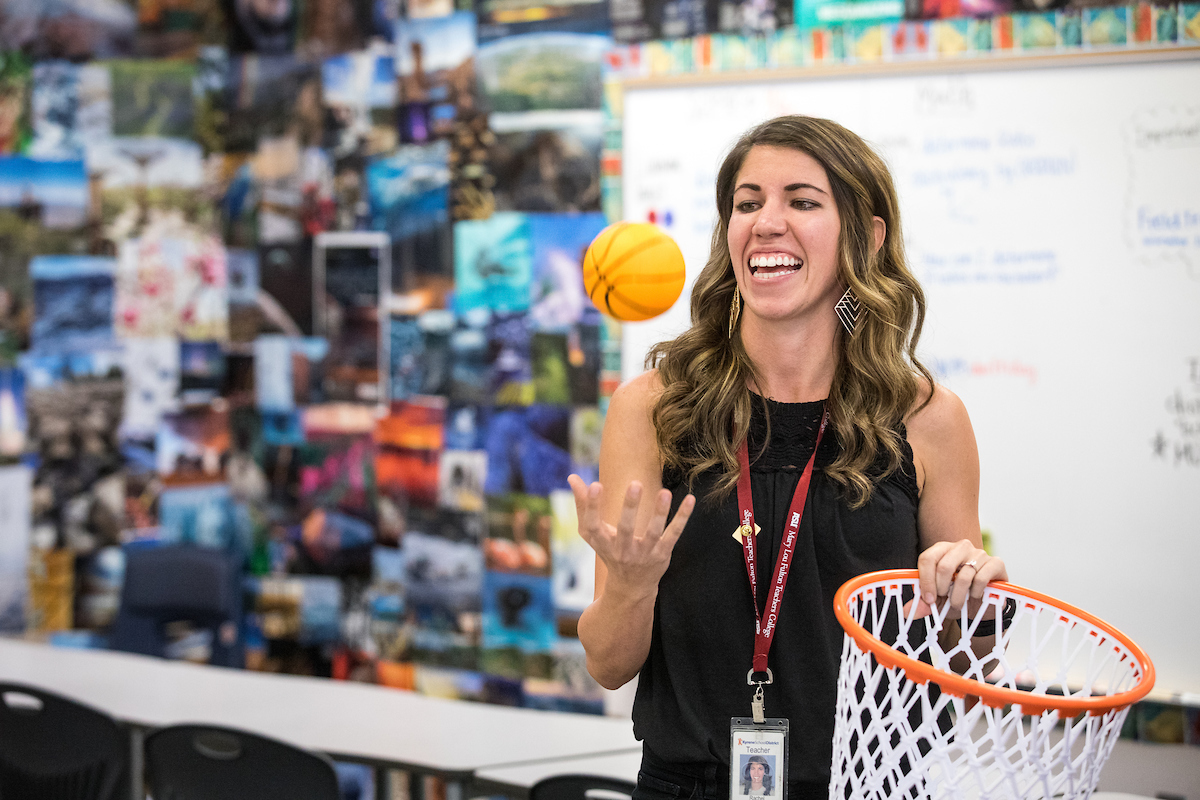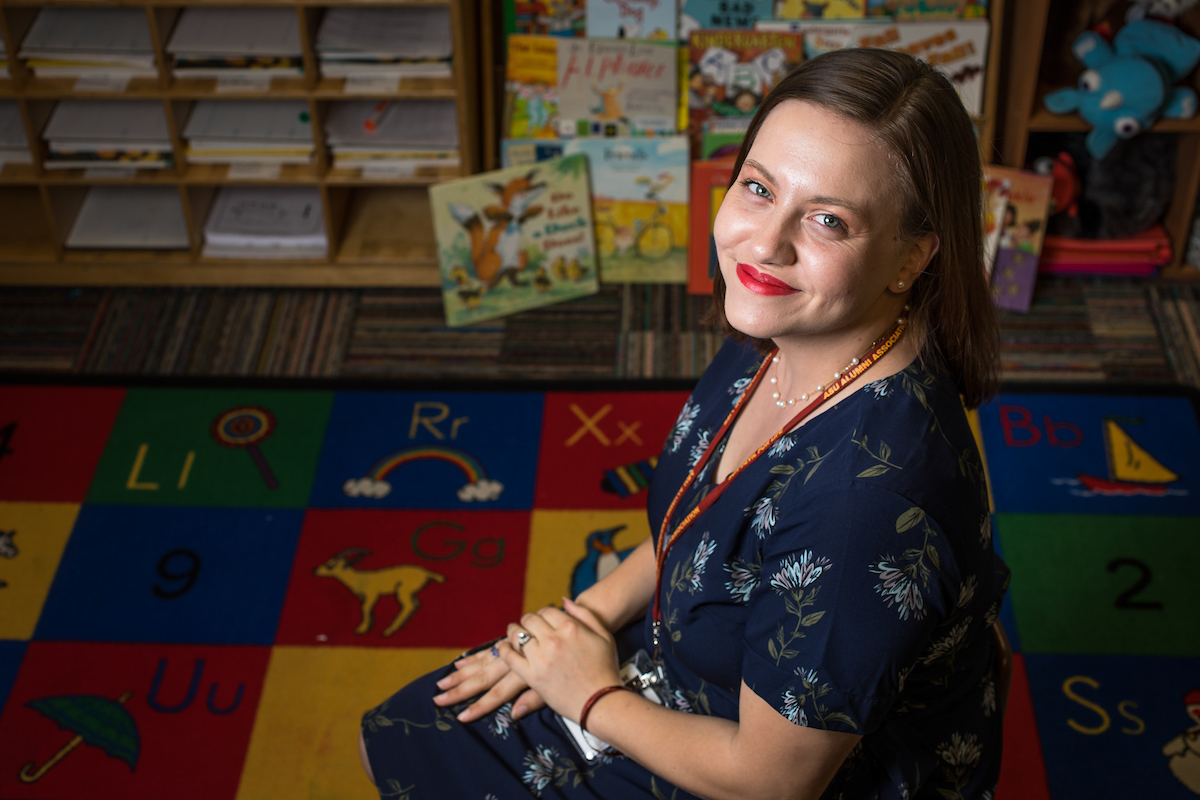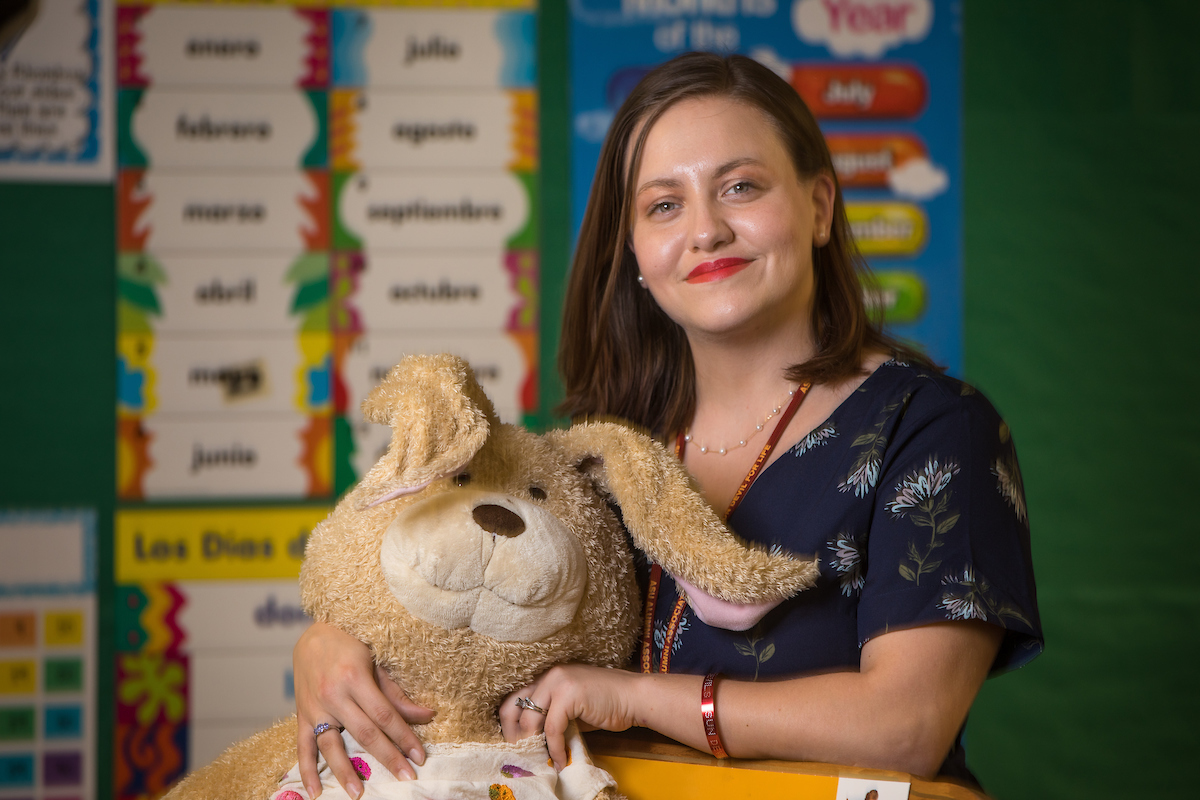ASU's teaching students learn their craft with an eye toward change from the inside out
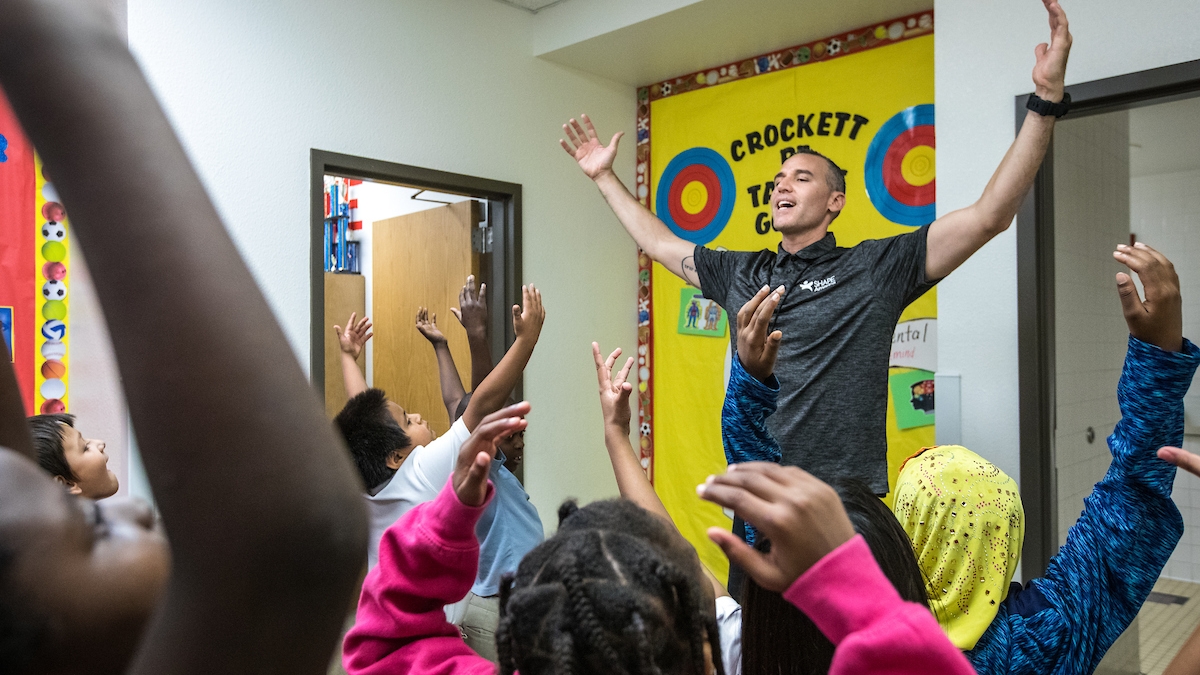
Editor's note: This story is being highlighted in ASU Now's year in review. Read more top stories from 2018 here.
While the nation’s schools continue to struggle to retain teachers, many Mary Lou Fulton Teachers College alumni are finding reasons to stay, advancing their careers and finding joy in classrooms.
Why do teachers quit? Besides the obvious — inadequate pay, lack of respect — teachers have often said their jobs can be rigid, repetitious, isolating and lacking in creativity.
It makes it difficult to even get to the three-year mark — a crucial milestone where only 50 percent of all Arizona teachers decide to remain in the professionThis figure is from a December 2017 report from the Arizona School Personnel Administrators Association. .
Arizona State University’s Mary Lou Fulton Teachers College recognizes this and is working alongside many school districts to redesign the workforce to reinvigorate the profession and make it more attractive.
“The time has never been better for teachers to engage students and personalize and differentiate instruction for learners, and graduates of our programs are very well set up to do that,” said Brent Maddin, co-director of the Division of Teacher Preparation and executive director for Educator Workforce Initiatives for Mary Lou Fulton Teachers College. “Phoenix is an exciting place to do some innovative work and help us to ask, ‘What does the future of education look like?’”
In February, MLFTC publicly unveiled its strategic initiatives at an event called “Education by Design: Innovation With Purpose in Schools and Systems” at the Phoenix Art Museum in front of 200 constituents.
It was there that the college’s dean, Carole G. Basile, announced that she sees hope in future students and educators who want the freedom to think and act creatively as individuals and in teams.
Basile often speaks of “creative intrapreneurs” to describe people who innovate from within professions or institutions, find new ways to push forward their organization and fields and take risks, looking beyond traditional boundaries.
Some of those cutting-edge instructors have already graduated through the MLFTC programs and are putting the skills they’ve learned there to work: Josh Meibos, a physical education instructor at Crockett Elementary; Rachel Manak, a sixth-grade teacher at Kyrene Centennial Middle School; and Angelina Cook, a kindergarten teacher at Eagle Ridge Elementary.
The aloha spirit invades the desert
Josh Meibos had it made.
Nearly a decade ago he was living in Hawaii, working for an international retailer and pulling down a nice salary.
But he wasn’t satisfied with his life chasing the brass ring.
“With a job like that, you’re always looking at what’s your next position going to be. I became friendly with the regional manager and I saw his lifestyle, and it wasn’t something that I wanted to fight for,” Meibos said. “You know when you’re living in Hawaii and you’re not happy, something’s wrong.”
Meibos said he caught some of the “aloha spirit” and had time to reflect on his life and career path. He thought back to his college days when he was a volleyball athlete and had several teaching and coaching opportunities.
He came up with a strategy: Get his master’s degree from ASU, teach in the States for a few years, then travel the world and instruct students from around the globe. As soon as he entered the master’s program at Mary Lou Fulton Teachers College, he knew he had made the right choice.
“I felt like I had met my tribe, my people,” Meibos said. “I definitely felt like I had found my passion.”
Meibos graduated with a Master of Physical Education degree in 2011 at age 30. Initially he found a teaching position in China, but two weeks before he was about to leave, a job opened up at Crockett Elementary in Phoenix's Balsz School District, which serves the largest refugee population in his district and where 17 different languages are spoken.
“The school’s diversity helped bring me a purpose to physical education and to students. I tell people I wanted to see the world, then I sit in this classroom with these kids and, in a way, the world came to me,” Meibos said. “If I wasn’t going to be here for these kids, who was? It all made me realize I can find roots right here.”
Crockett Elementary physical education teacher Josh Meibos leads his second-graders in rhythm exercises on Oct. 18. Meibos earned his master's degree from ASU in 2011 and is the 2018 Arizona Teacher of the Year for K-12 through the Arizona Educational Foundation. Photo by Charlie Leight/ASU Now
Meibos said society has marginalized many of his students and that there is hardly anyone to embrace them for who they are.
“It’s my job to help that little girl in the hijab or that Hispanic boy that enters my class (know) that they are 100 percent great for who they are because a lot of these students and their families live in fear,” Meibos said. “I teach them they can be anything they want to be and I get the privilege to teach them.”
But there was a time when Meibos said he felt like pulling up stakes and leaving the profession — around the three-year mark — because he didn’t feel there was much buy-in for him as a teacher.
“There were also other teachers who weren’t buying into it because they would leave so easily,” said Meibos, noting Arizona’s teaching shortage. “There was no consistency, no culture, and the kids were becoming difficult to manage. But I had great autonomy in my job and the freedom to create. That helped me stay.”
Meibos’ creativity manifests itself in many ways: He combines math and science into his physical education curriculum, and he’s big on team-building exercises, which he believes promotes empathy, confidence and good sportsmanship. He also makes his students journal about their experiences.
“The journals also gave me insight into my students, which helped me to better understand their experience and how I could adjust my teaching to their needs,” Meibos said. “They also get extra credit for language arts if they turn in the assignment.”
He also created a yoga program and supported his school’s efforts in launching a mindfulness program, both of which complement each other. Meibos said the two programs have not only improved his students’ flexibility, movement and breathing, but have improved their communication with others and confidence in themselves.
Video courtesy of Arizona Educational Foundation
“Three years ago this school had over 50 suspensions; this year they had two,” Meibos said. “They come into these classes and they start to identify who they are and realize we’re all the same people with the same goals. They begin to understand what you’re feeling and what I’m feeling.”
The state recently felt something for Meibos and honored him as the 2018 Arizona Teacher of the Year. Meibos received a $15,000 cash prize, a trip to the White House to meet President Donald Trump and a nomination for National Teacher of the Year.
The 40-year-old is starting a doctorate program in organizational leadership in January. One day he hopes to train and develop future Arizona teachers.
“A lot of what I have learned is through trial and error. I’ve failed many, many times,” Meibos said. “Then again, I have that freedom to fail and that’s very beneficial to me as an educator.”
Teaching is in her DNA
Rachel Manak wasn’t born to be a teacher, but it was awfully close.
She heeded the call of teaching when her instructor made a kind gesture on the first day of school.
“His name was Chris Warren, and he shook my hand and gave me a hug,” Manak said. “He was so kind and introduced himself to every kid like this. I thought, ‘Wow, I wanna be just like you!’”
As that year progressed, Manak found classroom learning stimulating and even took extra worksheets home to teach her younger siblings.
“I was a nerd to the max,” Manak said.
If Manak was a nerd, she balanced it out with a love for the outdoors and sports, having grown up in a small town in Colorado. She played high school basketball and today does trail running, mountain biking, rock climbing, hiking and yoga. She often incorporates sports-related activities into her teaching curriculum.
Manak graduated from Mary Lou Fulton Teachers College with her bachelor’s degree in elementary education in 2015 and teaches STEM subjects to sixth-graders at Kyrene Centennial Middle School in Phoenix. Prior to that, she taught seventh- and eighth-grade science in the Tucson Unified School District, an eye-opening experience, she says.
“I worked in a school where the students had tough home lives,” Manak said. “You hear the kids tell stories and your heart just sinks, and no amount of schooling can prepare you for that sort of thing. It weighs on you because as a teacher you develop a bond with your students and care about them.”
Then-student-teacher Rachel Manak goes over phases of the moon and eclipses with seventh-grade science students from Kyrene Del Pueblo Middle School in Chandler on May 8, 2015. Manak graduated that year from the Mary Lou Fulton Teachers College and now teaches STEM subjects to sixth-graders at Kyrene Centennial Middle School in Phoenix. Photo by Charlie Leight/ASU Now
Manak said the job also has other challenges — like trying to get along with 60 different personalities (she teaches two shifts of classes at Kyrene) and keeping them in check.
“These are 11- and 12-year-old students and about to hit puberty, and their hormones are going crazy,” Manak said. “You have to be consistent and if you don’t, you get walked all over.”
In times like those, Manak said she often relies on her MLFTC training that showed her how to engage with students personally and tap into their individuality and creativity to make learning fun.
Manak does that in a variety of ways. For example, her students get to shoot a miniature basketball through a hoop if they share what they learned about graphing ratios, or she’ll create math problems individualized for students’ interests.
She also set up a raffle system where two students draw at the end of each day and win prizes such as “Have a snack in class,” “Sit in the teacher’s chair for a day” or “Have lunch with the teacher and invite five friends.”
“These are positive things that make school fun and reinforce positive behavior,” Manak said. “Automatically their engagement level goes up.”
Manak also incorporates kinesthetic activities into learning concepts. Last year she taught on the concept of plate tectonics using a game based loosely on Simon Says. Manak said a lot of her teaching methods are through trial and error, and what works one year might fall flat on its face the following year.
“It all depends where the class is as a unit,” Manak said. “Teaching is like a puzzle in that you have to figure it out.”
Sixth-grade math and science teacher Rachel Manak uses a toy basketball and basket to engage her Kyrene Centennial Middle school students on Nov. 8. She graduated from ASU in May 2015 and has passed the three-year threshold in her teaching career. Manak says she knew she wanted to be a teacher since first grade and feeds on the support of the Kyrene School District administrators, fellow sixth-grade teachers and her current and former students. Photo by Charlie Leight/ASU Now
Manak was nominated for the Rising Star Excellence in Education Award by the Tempe Diablos in her third year of teaching, the same year half of her peers leave the profession. She said she understands how teachers can get frustrated and switch careers.
“This job requires an overwhelming amount of work, and it’s the major reason for teacher burnout,” Manak said. “You never really have a day where all of your work is done. It’s a career where you don’t get instant gratification … there is a ‘grass is greener’ syndrome going on.”
Manak believes it boils down to a simple equation.
“The job has to be a part of your DNA, and you have to be here for the right reasons,” Manak said. “You have to love what you do. Luckily, I do.”
MORE: Mary Lou Fulton Teachers College news
Hats off to this kindergarten teacher
MLFTC alumna Angelina Cook discovered in her first year that educators don’t wear one hat but several.
“We have so many different hats that we wear, and it’s especially true with kindergartners,” Cook said. “You’re a parent sometimes when they misbehave. You’re a nurse when they fall down. You’re judge, jury and executioner when something’s going on. But it’s wonderful.”
That’s how many people would describe the second-year kindergarten teacher, who graduated from Mary Lou Fulton Teachers College in 2017. Her warmth and caring is immediately evident, and she often refers to her students as her “kids” and “babies.”
She said education for her boils down to one thing: helping connect the dots for her students.
“My students are at an age where they don’t know how to express themselves, and it’s my job to decode what’s going on,” said Cook, who teaches at Eagle Ridge Elementary in the Paradise Valley School District in Phoenix. “Maybe they didn’t get enough sleep last night or maybe there’s something going on at home. Maybe they just missed breakfast and that just set them off. But when they learn and you see them getting excited and start connecting things, that’s what makes every day worth it.”
Eagle Ridge Elementary School kindergarten teacher Angelina Cook (shown in her north Phoenix classroom on Oct. 15) is only in her second year of teaching, after graduating from ASU in 2017. She plans to continue her career in education by getting a master’s degree in educational policy. Photo by Charlie Leight/ASU Now
Now in her second year, Cook understands that patience and pacing is the key to teaching kindergartners. She said they go at their own pace, and that in addition to learning basic concepts, she also oversees their emotional, social and moral development.
“You are teaching them what is right and wrong and how to use their words to tell how they feel,” Cook said. “If you do plan to teach them, you have to make the lesson 10 minutes max and then move on. Otherwise, you will have a flood of behavior problems.”
Cook uses an arsenal of weapons to keep their interest high, including interactive games, exercises, YouTube videos, toys, puzzles, puppets and whiteboards. Because Eagle Ridge is a 1-to-1 technology school, she also uses tablets in the classroom to enhance learning.
“You have to give students that sense of ‘I wonder what we’ll learn next?’ rather than worksheet, worksheet, worksheet,” Cook said. “I totally believe you have to incorporate your personality into the classroom rather than stand up front and deliver information in a monotone voice. If you make learning fun, it’ll be fun for the kids.”
She learned that in her student teaching through the ASU iTeach AZ program, which she credits for preparing her with everything from lesson planning and classroom management to creating a supportive community around her students and their parents.
“One of the things Mary Lou Fulton Teachers College taught me is to make your class a community and make connections with the parents,” Cook said. “Let them into the classroom and get them more involved by showing them, ‘Hey, public education is great! We want you to have fun with us.’”
She stays connected with parents through an educational app, texts, phone calls, newsletters and parent-teacher conferences.
“Because I am getting their babies, I want them to know my classroom is a safe and fun place,” Cook said. “If they need to talk, I tell them my door is always open and it’s been wonderful for them.”
Cook is also big on professional development and asking others for advice on how to improve her teaching, including Facebook groups.
Eagle Ridge Elementary School kindergarten teacher Angelina Cook creates a welcoming classroom for her "babies." Photo by Charlie Leight/ASU Now
“If you’ve tried something again and again and it isn’t working, then you have to look at your teaching,” Cook said. “Teachers can sometimes be stubborn. We should always be learning, always striving to do our best to expand our learning.”
And that’s exactly what Cook is doing. Recently she applied for the master’s degree program for educational policy at ASU.
“I want to make changes for those who are in education and those considering teaching,” Cook said. “I want to show them that we can make positive changes so we never hear again that Arizona is dead last in education.”
Top photo: Crockett Elementary physical education teacher Josh Meibos leads his second-graders in stretching exercises on Oct. 18. Meibos earned his master's degree from ASU in 2011 and is the 2018 Arizona Teacher of the Year for K-12 through the Arizona Educational Foundation. Photo by Charlie Leight/ASU Now
More Arts, humanities and education
Illuminating legacy at ASU
In 2020, the ASU Art Museum unveiled a groundbreaking installation, "Point Cloud (ASU)," by renowned artist Leo Villareal. The art piece was given a permanent home on the Tempe campus in 2024 thanks…

Name change for ASU's Mary Lou Fulton Teachers College reflects college's mission
Arizona State University’s Mary Lou Fulton Teachers College has a new name: the Mary Lou Fulton College for Teaching and Learning Innovation.The name change, which will be completed in time for the…

Exhibit to feature artwork inspired by oral histories from Arizona's oldest botanical garden
Though it is Arizona's largest botanical garden and has been an established touchstone of the community for more than 100 years, many students in Arizona State University Professor Ellen…
